How To Edge Garden Beds
The Best Garden and Lawn Edging Ideas & Tips
Three simple, attractive, low-maintenance garden and lawn edging ideas to inspire.
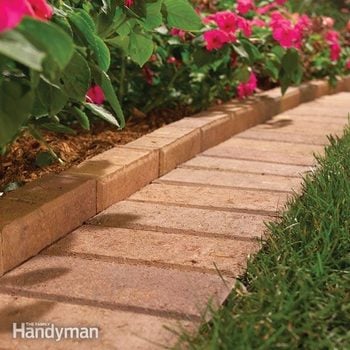 Family Handyman
Family Handyman
We show you how to edge a lawn with simple and attractive tips that keep grass from invading your garden and eliminate the need for edge trimming.
You might also like: TBD
- Time
- Complexity
- Cost
- A full day
- Beginner
- Varies
Lawn Edging: Metal: A Nearly Invisible Garden Border

Lawn Edging: Metal garden borders
Metal lawn edging subtly separates the lawn from the garden.
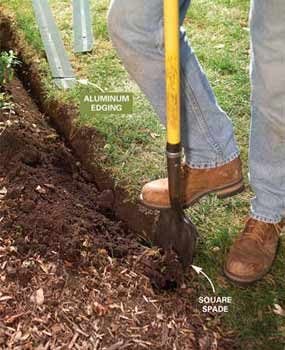
Lawn Edging: Photo 1: Dig the trench
Cut a narrow, 4-in. deep trench with one vertical side along the lawn edge. Shave the vertical edge to smooth out curves. Follow a string line for straight landscape border edging.
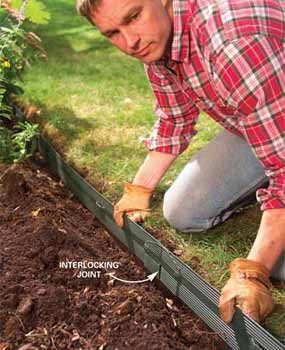
Lawn Edging Photo 2: Place the garden edging in the trench
Snap together the 8-ft. landscape borders, drop the garden edging into the trench and lay it against the vertical edge. Cut the final section to length with a hacksaw.
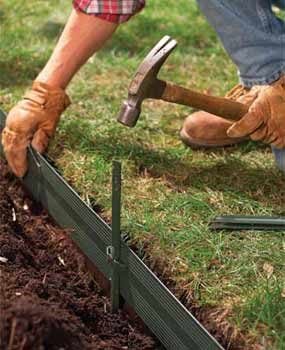
Lawn Edging Photo 3: Support the landscape edgers with stakes
Drive stakes to set the depth at about 1/2 in. above the soil level of the lawn. If the garden edging drops too low, pry it up with the tip of your shovel.

Lawn Edging: Photo 4: Backfill along the garden edging
Backfill the landscape edging with soil from the garden bed and compress it firmly. Leave room on top for mulch.
The simplest and most subtle landscape borders that effectively separate your lawn from a garden are 4-in.deep strips of steel, aluminum or plastic. The metal lawn edging bends easily into smooth, graceful curves and stops the spread of grass roots. However, painted aluminum and steel offer the sleekest, most refined garden edging look because they almost disappear against the grass and garden bed. The plastic types of garden edging have a prominent black bulge along the top edge. All work best on fairly even terrain; if you have a lot of dips and rises, it's easier to install a paver border.
Plus: You may want to consider flower bed fencing, if there are pests you need to keep out.
Although aluminum and steel landscape edging cost about the same, we chose aluminum because it was much lighter. It weighs about 41 lbs. per 100 ft., while steel weighs about 225. With aluminum landscape edging, you get a professional look without the heavy lifting.
Plan to set the garden border with the top edge about 1/2 in. above the soil level to maintain the lawn/garden separation and keep roots from crossing over the top. This makes the garden border almost invisible and allows you to mow right over the top. However, be aware that the top of the thin lawn edging can hurt bare feet. After cutting it, make sure you round off any sharp edges with a file.
Follow the photos for the basic garden edging installation techniques. The key to setting this garden border is to cut a clean vertical edge along the grass with a square spade (Photo 1). Then you can lay the garden border tightly against the edge when you stake and backfill it. There's no rule for shaping the edge. Simply follow the edges of your lawn, making smooth, gradual curves.To make smooth, sharp curves, bend the metal lawn edging around a circular form.
The thicker landscaping edgers better withstand those inevitable bumps and hard knocks that go with lawn mowing.
CAUTION
Call your local utilities or 811 to locate underground lines before you dig and install all edging.
Buying Lawn Edging
Steel landscape edging is the most common metal garden edging, although you might not find it at local nurseries. Look for it at larger garden centers or at landscape suppliers, which is where most pros get it. (Search "Landscape Equipment and Supplies" online.) Steel garden landscape edging comes in 4-in. wide by 10-ft. long strips in a variety of colors. Keep in mind that it'll eventually rust, especially in a salt environment. It's heavy, floppy stuff and needs almost full support when you transport it.
Aluminum garden landscape edging, besides being lighter and stiffer, won't rust and is also available in a wide variety of colors. Look for it through landscaping suppliers, although it might be difficult to find. You might have to order it. Be sure stakes are included with your purchase.
You'll find black plastic landscaping edging at every garden center and home center, sometimes in both regular and heavy-duty thicknesses. Buy the thicker landscaping edging material. The thicker landscaping edgers better withstands those inevitable bumps and hard knocks that go with lawn mowing.
A Paver Garden Border: Edging Stones
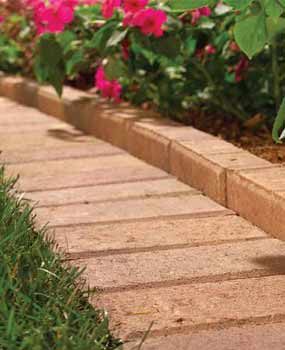
Paver border
Pavers provide a wide lawn edging border that keeps grass out of the garden.

Concrete and brick pavers
Pavers are available in a variety of colors and shapes.
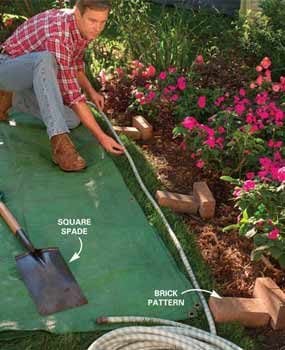
Photo 1: Identify the garden border
Lay out the border of the lawn edging with a garden hose, using the brick pattern as a spacer. Make curves gradual and smooth.
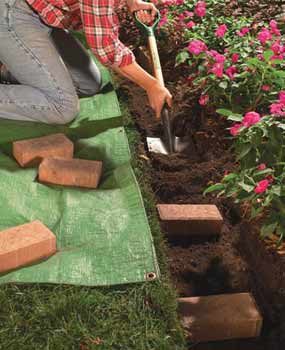
Photo 2: Dig a wide trench
Dig a 4-in. deep trench about an inch wider than the brick pattern, using a square spade. Cut the edge along the grass smooth and square.

Photo 3: Fill the trench with fabric and sand
Cut landscape fabric to fit the bottom and sides of the trench and dump in about 2 in. of sand. Smooth and flatten the sand with a block of wood.
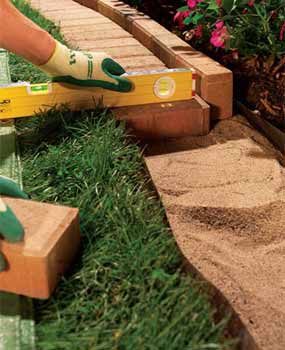
Photo 4: Lay the edging stones on the sand
Set the bricks tightly together so the tops and front edges are even and about 1/2 in. above the soil. Sweep sand into gaps and pack soil against the back side of the lawn edging.
If you're having trouble deciding between various lawn edging ideas, consider concrete or brick pavers. They make a simple, handsome border and work well as lawn edging material too. They're ideal when you want a wide border that keeps grass out of the garden, yet allows flowers and other plants to spill over without intruding onto the grass. You're less likely to chop them up with the lawn mower.
The paver design shown here also provides a nice, flat surface for the lawn mower wheel to roll along and make a clean cut. You shouldn't have to trim the edges after mowing. Concrete pavers are designed for rugged outdoor use. Brick pavers are too, but don't confuse them with regular bricks, which are typically softer and more likely to break down. Set the pavers in a bed of sand for easier positioning and leveling (Photo 3).
The sand bed that you lay over landscape fabric keeps most grass types from sending roots under the lawn edging and getting into your garden. Paver borders work well for straight, formal gardens but even better for informal yards with gradual curves and varying slopes. You can easily adjust them to follow the contours of an uneven yard. But they won't fit as well on tighter curves unless you alter the design and are willing to cut them to fit with a diamond blade saw.
Use a garden hose to mark the shape and gradual curves of your lawn edging (Photo 1). Don't hesitate to trim the trench a bit here or there as you cut the edge to smooth curves or alter the garden bed shape. For straight borders, follow a tightly stretched string line. Follow the photos for installing the pavers. It's important to set the front edge of the pavers about 1/2 in. above the soil in the lawn so the lawn mower can cut the grass cleanly. We also leveled our pavers from front to back to keep the row from dipping and rising, but it's not necessary and on slopes might look better if set on an angle. Just make sure the top of each paver sits flush with its neighbor and that the front edges create a smooth line. You can go back later and whack them perfectly flush with a block of wood and a hammer or a rubber mallet. The pavers we set on edge are primarily decorative, but they also raise the garden bed slightly and help retain mulch. Set them higher or lower to fit the needs of your garden.
A Raised-Bed Border
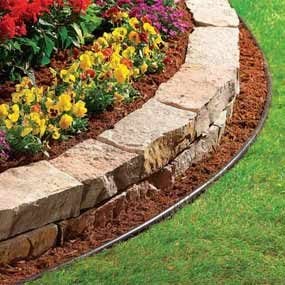
Raised-bed border
A raised border adds depth and texture to the garden.

Stacking edging stone
You can choose from a variety of attractive stone for your border.

Photo 1: Dig a trench
Mark the path of the border with paint, then dig a 4-in. deep trench along the line. Make the width the stone width plus 6 in.

Photo 2: Fill the trench with gravel
Pack in and level a bed of gravel. Keep the height at or below the soil level. If necessary on slopes, plan to step the stone up or down.

Photo 3: Set the first row of stone
Lay the first row of stones about 4 in. back from the grass edge. Push in more gravel or dig it out to align and level them. Wear goggles when chipping stones.
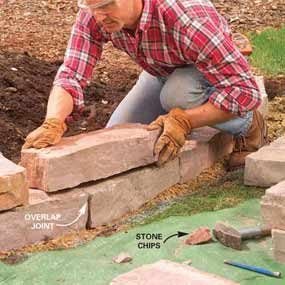
Photo 4: Lay the second row
Stack the second row of stones onto the first, overlapping the joints. Test several stones to find the most stable fit.

Photo 5: Fill the raised bed with topsoil
Lay a strip of landscape fabric against the back of the stones and fill the planting bed with topsoil. Trim off excess fabric later.

Photo 6: Install plastic edge along the front
Scoop out 4 in. of gravel in front of the wall and install plastic lawn edging. Pack mulch into the gap between the plastic and stone.
A stone wall does more than make a clean border along your lawn. It's a handsome visual statement in itself, a great way to add depth and texture to a flat, featureless yard. It's practical, too.
When looking at paver lawn edging ideas, be sure to explore the variety of stone materials, sizes and shapes to create your ideal landscape border. It also provides good drainage, making it a great solution for low-lying, soggy gardens. And it's a good way to terrace a sloped yard and create nice, flat gardens.
To reduce maintenance we added a 4-in. deep trench that we lined with plastic edging and filled with mulch. The lawn edging keeps grass roots from creeping into the stone wall, and the mulch provides a mowing track for lawn mower wheels. With taller types of grass, you can mow right over the plastic border and cut the lawn edge cleanly. There's no need to trim the grass.
This project doesn't require any special skills, just a strong back. For metal lawn edging you'll need a hacksaw, and for stone lawn edging you'll need a cold chisel. Remember to wear safety googles when installing your landscape edging. Design your raised bed to blend into the contours of your yard like a natural feature. You can handle slopes in one of two ways. Either let your wall follow the slope of the yard for an informal look, or level the stones as we did and step the wall up or down as the slope requires to maintain approximately the same height.
The exact size of stacking stone for walls varies considerably by region. Visit a local landscape supplier to check types. (Ours is Chilton limestone.) For lawn edging, limit the height of your wall to two courses so you won't have stones falling out. Measure your wall length and make a sketch.
The stone dealer will help you figure out the quantities of all the materials you need. The stone will probably be sold by the ton or pallet and it's heavy. Have it delivered and dropped as close to the wall location as possible. And have gravel or sand delivered to use as a setting bed for the stone (Photo 2) as well as topsoil to fill behind the wall (Photo 5). The stone or landscaping dealer will help you calculate how much of these you need.
Follow the photos for step-by-step instructions on how to edge a lawn with stone. Get started by laying out the border with a garden hose or paint. We drew a curve by setting a string at a center point and marking an arc with paint (Photo 1). The trench width will vary depending on the width of the stone. Add 6 in. to the stone width (2 in. for the mowing edge plus 4 in. extra).
Generally it's best to keep the bottom row of stone an inch or so below the original soil level, but this will vary if you keep the stones level and the yard isn't level (what yard is?). If you're considering this lawn edging idea, just know that you may need to step the stones up or down, or use thinner or thicker stones depending on aesthetic and fit. There's no rule here. Experiment when you lay the stones for the best appearance.
Lay the stones that have the most irregular faces in the first row so you can place the irregular face down in the gravel and level the top (Photo 3). Vary the sizes and colors for the best look. Chip off irregularities with the maul and chisel. Then add the second row (Photo 4). Make this row as stable as possible so the stones won't rock and fall off. As a last resort, stabilize the stones by shoving stone chips into the gaps.
Lay landscape fabric against the back of the wall before backfilling to keep dirt from washing out through the stone (Photo 5). Then install the plastic edging in front. Add organic mulch to finish up the mowing edge.
Similar Projects
How To Edge Garden Beds
Source: https://www.familyhandyman.com/project/the-best-garden-bed-edging-tips/
Posted by: falconefifue1964.blogspot.com

0 Response to "How To Edge Garden Beds"
Post a Comment